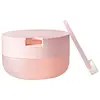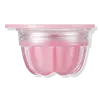What's inside
What's inside
 Key Ingredients
Key Ingredients

 Benefits
Benefits

 Concerns
Concerns

 Ingredients Side-by-side
Ingredients Side-by-side

Hydrogenated Poly(C6-14 Olefin)
EmollientHydrogenated Polyisobutene
EmollientEthylene/Propylene/Styrene Copolymer
Caprylic/Capric Triglyceride
MaskingTocopheryl Acetate
AntioxidantSqualane
EmollientWater
Skin ConditioningStearyl Alcohol
EmollientLithospermum Erythrorhizon Root Extract
Skin ConditioningCetyl Alcohol
EmollientParfum
MaskingButylene/Ethylene/Styrene Copolymer
Myristyl Alcohol
EmollientHydrogenated Olive Oil Cetyl Esters
Emulsion StabilisingOryza Sativa Bran Wax
Skin ConditioningHydrogenated Lecithin
EmulsifyingButylene Glycol
HumectantCitronellol
PerfumingPentaerythrityl Tetra-Di-T-Butyl Hydroxyhydrocinnamate
AntioxidantMenthoxypropanediol
MaskingLinalool
PerfumingCeramide AP
Skin Conditioning1,2-Hexanediol
Skin ConditioningGeraniol
PerfumingLimonene
PerfumingCholesterol
EmollientCI 77492
Cosmetic ColorantHexyl Cinnamal
PerfumingCeramide NP
Skin ConditioningPropanediol
SolventPalmitic Acid
EmollientStearic Acid
CleansingGlycine Max Polypeptide
Skin ConditioningSodium Hyaluronate
HumectantEthylhexylglycerin
Skin ConditioningDisodium EDTA
Hydrolyzed Collagen
EmollientHydrolyzed Hyaluronic Acid
HumectantSodium Hyaluronate Crosspolymer
HumectantHyaluronic Acid
HumectantPaeonia Albiflora Root Extract
Skin ConditioningSodium Acetylated Hyaluronate
HumectantPaeonia Albiflora Flower Extract
TonicHydrogenated Poly(C6-14 Olefin), Hydrogenated Polyisobutene, Ethylene/Propylene/Styrene Copolymer, Caprylic/Capric Triglyceride, Tocopheryl Acetate, Squalane, Water, Stearyl Alcohol, Lithospermum Erythrorhizon Root Extract, Cetyl Alcohol, Parfum, Butylene/Ethylene/Styrene Copolymer, Myristyl Alcohol, Hydrogenated Olive Oil Cetyl Esters, Oryza Sativa Bran Wax, Hydrogenated Lecithin, Butylene Glycol, Citronellol, Pentaerythrityl Tetra-Di-T-Butyl Hydroxyhydrocinnamate, Menthoxypropanediol, Linalool, Ceramide AP, 1,2-Hexanediol, Geraniol, Limonene, Cholesterol, CI 77492, Hexyl Cinnamal, Ceramide NP, Propanediol, Palmitic Acid, Stearic Acid, Glycine Max Polypeptide, Sodium Hyaluronate, Ethylhexylglycerin, Disodium EDTA, Hydrolyzed Collagen, Hydrolyzed Hyaluronic Acid, Sodium Hyaluronate Crosspolymer, Hyaluronic Acid, Paeonia Albiflora Root Extract, Sodium Acetylated Hyaluronate, Paeonia Albiflora Flower Extract
Diisostearyl Malate
EmollientPolybutene
Hydrogenated Polyisobutene
EmollientTrimethylolpropane Triisostearate
EmollientPentaerythrityl Tetraisostearate
EmollientSilica Dimethyl Silylate
EmollientHydroxystearic Acid
CleansingPhenyl Trimethicone
Skin ConditioningEthylene/Propylene/Styrene Copolymer
Parfum
MaskingTocopheryl Acetate
AntioxidantBenzyl Benzoate
AntimicrobialDehydroacetic Acid
PreservativeLinalool
PerfumingButylene/Ethylene/Styrene Copolymer
Limonene
PerfumingHexyl Cinnamal
PerfumingPentaerythrityl Tetra-Di-T-Butyl Hydroxyhydrocinnamate
AntioxidantLitchi Chinensis Fruit Extract
Skin ConditioningWater
Skin ConditioningButylene Glycol
Humectant1,2-Hexanediol
Skin ConditioningDiisostearyl Malate, Polybutene, Hydrogenated Polyisobutene, Trimethylolpropane Triisostearate, Pentaerythrityl Tetraisostearate, Silica Dimethyl Silylate, Hydroxystearic Acid, Phenyl Trimethicone, Ethylene/Propylene/Styrene Copolymer, Parfum, Tocopheryl Acetate, Benzyl Benzoate, Dehydroacetic Acid, Linalool, Butylene/Ethylene/Styrene Copolymer, Limonene, Hexyl Cinnamal, Pentaerythrityl Tetra-Di-T-Butyl Hydroxyhydrocinnamate, Litchi Chinensis Fruit Extract, Water, Butylene Glycol, 1,2-Hexanediol
 Reviews
Reviews

Ingredients Explained
These ingredients are found in both products.
Ingredients higher up in an ingredient list are typically present in a larger amount.
1,2-Hexanediol is a synthetic liquid and another multi-functional powerhouse.
It is a:
- Humectant, drawing moisture into the skin
- Emollient, helping to soften skin
- Solvent, dispersing and stabilizing formulas
- Preservative booster, enhancing the antimicrobial activity of other preservatives
Butylene Glycol (or BG) is used within cosmetic products for a few different reasons:
Overall, Butylene Glycol is a safe and well-rounded ingredient that works well with other ingredients.
Though this ingredient works well with most skin types, some people with sensitive skin may experience a reaction such as allergic rashes, closed comedones, or itchiness.
Learn more about Butylene GlycolWe don't have a description for Butylene/Ethylene/Styrene Copolymer yet.
We don't have a description for Ethylene/Propylene/Styrene Copolymer yet.
Hexyl Cinnamal is a fragrance ingredient with a similar scent to jasmine. It can be naturally found in chamomile essential oil.
This ingredient is a known EU allergen and may sensitize the skin. The EU requires this ingredient to be listed separately on an ingredients list.
Hexyl Cinnamal is not water soluble but is soluble in oils.
Learn more about Hexyl CinnamalHydrogenated Polyisobutene is a synthetic polymer. Polymers are compounds with high molecular weight. Hydrogenated Polyisobutene is an emollient and texture enhancer.
In one study, Hydrogenated Polyisobutene showed better skin hydration levels than Caprylic/Capric Triglyceride. As an emollient, it helps keep your skin soft and hydrated by trapping moisture in.
Hydrogenated Polyisobutene is often used as a mineral oil replacement.
Learn more about Hydrogenated PolyisobuteneLimonene is a fragrance that adds scent and taste to a formulation.
It's found in the peel oil of citrus fruits and other plants such as lavender and eucalyptus. The scent of limonene is generally described as "sweet citrus".
Limonene acts as an antioxidant, meaning it helps neutralize free radicals.
When exposed to air, oxidized limonene may sensitize the skin. Because of this, limonene is often avoided by people with sensitive skin.
The term 'fragrance' is not regulated in many countries. In many cases, it is up to the brand to define this term. For instance, many brands choose to label themselves as "fragrance-free" because they are not using synthetic fragrances. However, their products may still contain ingredients such as essential oils that are considered a fragrance.
Learn more about LimoneneLinalool is a fragrance and helps add scent to products. It's derived from common plants such as cinnamon, mint, citrus, and lavender.
Like Limonene, this ingredient oxidizes when exposed to air. Oxidized linalool can cause allergies and skin sensitivity.
This ingredient has a scent that is floral, spicy tropical, and citrus-like.
Learn more about LinaloolParfum is a catch-all term for an ingredient or more that is used to give a scent to products.
Also called "fragrance", this ingredient can be a blend of hundreds of chemicals or plant oils. This means every product with "fragrance" or "parfum" in the ingredients list is a different mixture.
For instance, Habanolide is a proprietary trade name for a specific aroma chemical. When used as a fragrance ingredient in cosmetics, most aroma chemicals fall under the broad labeling category of “FRAGRANCE” or “PARFUM” according to EU and US regulations.
The term 'parfum' or 'fragrance' is not regulated in many countries. In many cases, it is up to the brand to define this term.
For instance, many brands choose to label themselves as "fragrance-free" because they are not using synthetic fragrances. However, their products may still contain ingredients such as essential oils that are considered a fragrance by INCI standards.
One example is Calendula flower extract. Calendula is an essential oil that still imparts a scent or 'fragrance'.
Depending on the blend, the ingredients in the mixture can cause allergies and sensitivities on the skin. Some ingredients that are known EU allergens include linalool and citronellol.
Parfum can also be used to mask or cover an unpleasant scent.
The bottom line is: not all fragrances/parfum/ingredients are created equally. If you are worried about fragrances, we recommend taking a closer look at an ingredient. And of course, we always recommend speaking with a professional.
Learn more about ParfumPentaerythrityl Tetra-Di-T-Butyl Hydroxyhydrocinnamate (long name, huh?) is a synthetic antioxidant.
It is used to help stabilize other antioxidants or prevent the color from changing in a product.
As an antioxidant, it helps fight free-radical molecules. Free-radical molecules are capable of damaging our cells and other genetic material. Thus, antioxidants may reduce the signs of aging.
This ingredient is oil-soluble.
Learn more about Pentaerythrityl Tetra-Di-T-Butyl HydroxyhydrocinnamateTocopheryl Acetate is AKA Vitamin E. It is an antioxidant and protects your skin from free radicals. Free radicals damage the skin by breaking down collagen.
One study found using Tocopheryl Acetate with Vitamin C decreased the number of sunburned cells.
Tocopheryl Acetate is commonly found in both skincare and dietary supplements.
Learn more about Tocopheryl AcetateWater. It's the most common cosmetic ingredient of all. You'll usually see it at the top of ingredient lists, meaning that it makes up the largest part of the product.
So why is it so popular? Water most often acts as a solvent - this means that it helps dissolve other ingredients into the formulation.
You'll also recognize water as that liquid we all need to stay alive. If you see this, drink a glass of water. Stay hydrated!
Learn more about Water